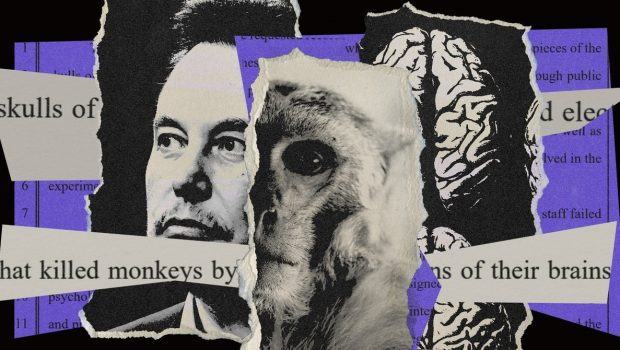How Neuralink Keeps Dead Monkey Photos Secret
The tan macaque with the hairless pink face could do little more than sit and shiver as her brain began to swell. The California National Primate Center staff observing her via livestream knew the signs. Whatever had been done had left her with a “severe neurological defect,” and it was time to put the monkey to sleep. But the client protested; the Neuralink scientist whose experiment left the 7-year-old monkey’s brain mutilated wanted to wait another day. And so they did.
As the attending staff sat back and observed, the monkey seized and vomited. Her pupils reacted less and less to the light. Her right leg went limp, and she could no longer support the weight of her 15-pound body without gripping the bars of her cage. One attendant moved a heat lamp beside her to try to stop her shaking. Sometimes she would wake and scratch at her throat, retching and gasping for air, before collapsing again, exhausted.
An autopsy would later reveal that the mounting pressure inside her skull had deformed and ruptured her brain. A toxic adhesive around the Neuralink implant bolted to her skull had leaked internally. The resulting inflammation had caused painful pressure on a part of the brain producing cerebrospinal fluid, the slick, translucent substance in which the brain sits normally buoyant. The hind quarter of her brain visibly poked out of the base of her skull.
On September 13, 2018, she was euthanized, records obtained by WIRED show. This episode, regulators later acknowledged, was a violation of the US Animal Welfare Act; a federal law meant to set minimally acceptable standards for the handling, housing, and feeding of research animals. There would be no consequences, however. Between 2016 and 2021, the United States Department of Agriculture (USDA) enforced the humane treatment of animals through what it called “teachable moments.” Because the center—home to a colony of nearly 5,000 primates run by the University of California–Davis—had proactively reported the violation, it could not be legally cited.
And neither could Neuralink. “If you want to split hairs,” a former employee tells WIRED, “the implant itself did not cause death. We sacrificed her to end her suffering.” The employee, who signed a confidentiality agreement, asked not to be identified.
Got a Tip?
Missing from the veterinary records released by the university are hundreds of photographs taken by the primate center’s staff between 2018 and 2020 of Neuralink’s test subjects. Though publicly funded, thus bound by California’s open records law, UC Davis has fought disclosure of the photographs for more than a year. Releasing them, it says, would not serve the public’s interest.
Meanwhile, videos of the experiments have seemingly vanished. Documents obtained by WIRED show that the primate center’s staff wrote about reviewing a “tape” of the aforesaid monkey hours before they stopped her heart. The school has not acknowledged that such a tape exists, and Neuralink, whose partnership with the school ended three years ago, was permitted to store its own footage and remove it from the property when it wished.
“They provided their own computing infrastructure, and they had their own network connection, and they have removed their computing infrastructure from the premises,” the school said in a September 2021 email to the Physicians Committee for Responsible Medicine, which is suing UC Davis for the release of images and videos of Neuralink’s experiments there. “The IT staff at the California National Primate Research Center were in no way involved with any aspects of the creation or storage of Neuralink’s video content,” the school added.








Gloss